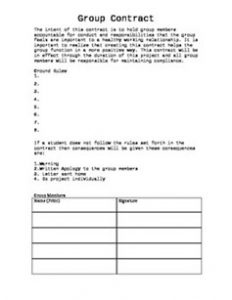Student Contributor: H. Brown
 Group contracts can be used as a guide to running group tasks smoothly and effectively. Because each member should participate in making group expectations, they are more likely to abide by them. this will help reduce any arising conflicts/misbehavior while students are working together.
Group contracts can be used as a guide to running group tasks smoothly and effectively. Because each member should participate in making group expectations, they are more likely to abide by them. this will help reduce any arising conflicts/misbehavior while students are working together.
This tool is used best prior to big group projects that are more long-term, rather than just one day during a class. This contract is personal to each group and will help as a guide for students as they work together. The group contract should include expectations that the students have for each other as well as the classroom expectations students should already know. This can be done with a whole class discussion as the teacher writes down the students’ ideas to be selected from or in higher grades this can be created simply with the small group of students that are working together. Once students write their expectations, they will brainstorm consequences for violating the expectations they created. Students will sign this contract to show they will do their best with following the group expectations. From experience, students are more likely to follow the expectations when they take part in creating them, so incorporate student ideas as much as you can.
 Writing a group contract best fits with the preventative phase of classroom management. This is because the tool is used to help guide students to achieve the project outcomes and smoothly work together as a team. This is a powerful tool to use and teach students accountability, as group members will hold each other to higher standards than normally from creating the contract together with promising full effort from each student. This tool is helpful to keep each student fulfilling their role within the group as well as preventing misbehavior/arising issues during group work time. The contract can also be used as a reminder during the group work to redirect students to what they are asked to do by their peers and teacher, which is how it correlates to the corrective phase of management. It can be argued that the contract overall helps support the group with achieving success, however, the supportive and preventative phases can intertwine. This tool can fall under any theory of influence depending on how the teacher uses it. If the teacher were to create the expectations for the groups to simply follow and sign this would make the tool be teacher-directed. The teacher could create a list of expectations for students to choose from, which would be teacher-directed & collaborative, and or collaborative. I believe this tool is most beneficial and best fits with the student-directed, student-directed & collaborative theory of influence. The contract expectations and consequences should be created with or by the students. I say this because when students create the expectations, they are more willing to abide by them, resulting in a smoother process and fewer misbehaviors.
Writing a group contract best fits with the preventative phase of classroom management. This is because the tool is used to help guide students to achieve the project outcomes and smoothly work together as a team. This is a powerful tool to use and teach students accountability, as group members will hold each other to higher standards than normally from creating the contract together with promising full effort from each student. This tool is helpful to keep each student fulfilling their role within the group as well as preventing misbehavior/arising issues during group work time. The contract can also be used as a reminder during the group work to redirect students to what they are asked to do by their peers and teacher, which is how it correlates to the corrective phase of management. It can be argued that the contract overall helps support the group with achieving success, however, the supportive and preventative phases can intertwine. This tool can fall under any theory of influence depending on how the teacher uses it. If the teacher were to create the expectations for the groups to simply follow and sign this would make the tool be teacher-directed. The teacher could create a list of expectations for students to choose from, which would be teacher-directed & collaborative, and or collaborative. I believe this tool is most beneficial and best fits with the student-directed, student-directed & collaborative theory of influence. The contract expectations and consequences should be created with or by the students. I say this because when students create the expectations, they are more willing to abide by them, resulting in a smoother process and fewer misbehaviors.
More Information –
Tool Source: I don’t remember from who, but I got this idea from one of my past classes where I had to help create and sign a group contract.
https://bit.ly/3FBk2cf


